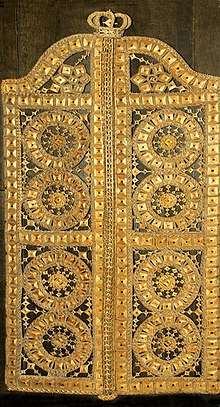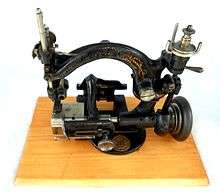Straw plaiting
Straw plaiting is a method of manufacturing textiles by braiding straw and the industry that surrounds the craft of producing these straw manufactures. Straw is plaited to produce products including straw hats and ornaments, and the process is undertaken in a number of locations worldwide.

Etymology

To plait comes from late 14c., "to fold, gather in pleats," also "to braid or weave," from Old French pleir "to fold," variant of ploier, ployer "to fold, bend," from Latin plicare "to fold" [1]
Applications
Straw can be plaited for a number of purposes, including: the thatching of roofs, to create a paper-making material, for ornamenting small surfaces as a "straw-mosaic", for plaiting into door and table mats, mattresses and for weaving and plaiting into light baskets and to create artificial flowers. Straw is also plaited to produce bonnets and hats.
England

The plaiting of straw in the counties of Buckinghamshire, Bedfordshire, Berkshire and Hertfordshire formerly gave employment to many thousands of women and young children; but this had largely ended by the beginning of the 20th century: the number of English plaiters, all told, was not more than a few hundreds in 1907, as compared with 30,000 in 1871.[2]
The districts around Luton in Bedfordshire and the neighbouring counties[3] were, since the beginning of the 17th century, the British home of the straw-plait industry. The straw of certain varieties of wheat cultivated in that region is, in favourable seasons, possessed of a fine bright color and due to tenacity and strength. The straw is cut as in ordinary harvesting, but is allowed to dry in the sun, before binding. Subsequently straws are selected from the sheaves, and of these the pipes of the two upper joints are taken for plaiting. The pipes are assorted into sizes by passing them through graduated openings in a grilled wire frame, and those of good color are bleached by the fumes of sulphur. Spotted and discoloured straws are dyed either in pipe or in plait. The plaiters work up the material in a damp state, either into whole straw or split straw plaits. Split straws are prepared with the aid of a small instrument having a projecting point which enters the straw pipe, and from which radiate the number of knife-edged cutters into which the straw is to be split. The straws were put through a small mangle to flatten them. They were then braided to produce a woven strip which was sold on to the makers of hats, baskets and other wares.[4]
The plaiting was carried out by women and children who were taught the skills in plait schools. At its peak in the early nineteenth century a woman could earn more by plaiting than a man could earn on the land. There was concern that the industry led to dissolution and idleness in the menfolk.[5]
The English industry was eventually killed by free trade from 1860 which allowed cheap imports of plait from Italy and later China and Japan.
Tuscany
Worldwide, the most valuable straw for plaits is grown in Tuscany, and from it the well-known Tuscan plaits and Leghorn hats are made. The straw of Tuscany, specially grown for plaiting, is distinguished into three grades of quality. The highest quality is Pontederas Semone, the second highest is Mazzuolo. The bulk of the plaits are made from this grade of straw. The third grade, Santa Fioro, is only used to plait "Tuscan pedals" and braids. The wheat-seed for these straws is sown very thickly on comparatively elevated and arid land, and it sends up long attenuated stalks. When the grain in the ear is about half developed the straw is pulled up by the roots, dried in the sun, and subsequently spread out for several successive days to be bleached under the influence of alternate sunlight and night-dews. The pipe of the upper joint alone is selected for plaiting, the remainder of the straw being used for other purposes. These pipes are made up in small bundles, bleached in sulfur fumes in a closed chest; assorted into sizes, and so prepared for the plaiters. Straw-plaiting is a domestic industry among the women and young children of Tuscany and some parts of Emilia. Tuscan plaits and hats vary enormously in quality and value; the plait of a hat of good quality may represent the work of four or five days, while hats of the highest quality may each occupy six to nine months in making. The finest work is excessively trying to the eyes of the plaiters, who can at most give to it two or three hours' labor daily.
Oceania in 1896
Friedrich Ratzel in The History of Mankind[6] reported as follows:-
- The art of plaiting is diligently practised. For the coarser mats coco-nut fibre is employed; for the finer, pandanus leaves and rushes. An intelligent Fijian can always tell you from which island a mat came. The coarser kinds are used as floorcloths and hangings to the huts; the finer as sails, or sleeping-mats, or for children. Floor-mats are 5 to 8 yards in length, sail-mats 100 and more. Sleeping-mats are of two kinds - a thicker to lie on, and a thinner for covering; one of the most valued sorts has a pleat running through the middle of each strip of plaiting. Borders are worked on with designs in darker bands; white feathers and scraps of European stuffs are woven in. One of the prettiest productions of the art is the women's liku, a girdle woven from strips of the bast of the wau-tree (a kind of hibiscus), with the fibres of a root that grows wild, and blades of grass. Soft mats are made by plaiting the stalks of a fibrous plant into one, and removing the woody portions by bending and beating. Bags and baskets are admirably woven; fans, too, are made either of palm leaves strengthened at the edge and vandyked, or woven from bast. But superior to all these are the string and the cables - the best from coco-fibre, the inferior kinds from the bast of the wau-tree. In the Fiji Islands these are tastefully made up into balls, ovals, spindles, etc. Comparison with New Caledonia shows how high East Melanesia stands in this art. One has only to look at a New Caledonia fan beside one from Fiji. But in New Guinea, again, very elegant woven articles of all kinds are produced.
See also
- Corn dolly, figures constructed from plaited straw with an ancient religious significance.
- Straw painting
Notes
- http://www.etymonline.com/index.php?term=plait
- Chisholm 1911, p. 1005.
- "The Hat Story". British Hat Guild. 2003. Archived from the original on 2007-09-27. Retrieved 2007-08-18.
- Yaxley, Chapter 6
- Yaxley, Chapter 6
- Ratzel, Friedrich. The History of Mankind. (London: MacMillan, 1896). URL: www. inquirewithin. biz/history/american_pacific/oceania/oceania-cloth.htm accessed 1 December 2009.
References
- Gróf, László (1988). Children of Straw - The story of a Vanished Craft and Industry in Bucks, Herts, Beds and Essex. Southampton, England: Barracuda Books. ISBN 0-86023-290-5.
- Yaxley, Susan; et al. (1981) [1973]. "6". History of Hemel Hempstead. Amplion Press: Hemel Hempstead Local History and Records Society. ISBN 0-9502743-0-5.
Attribution
